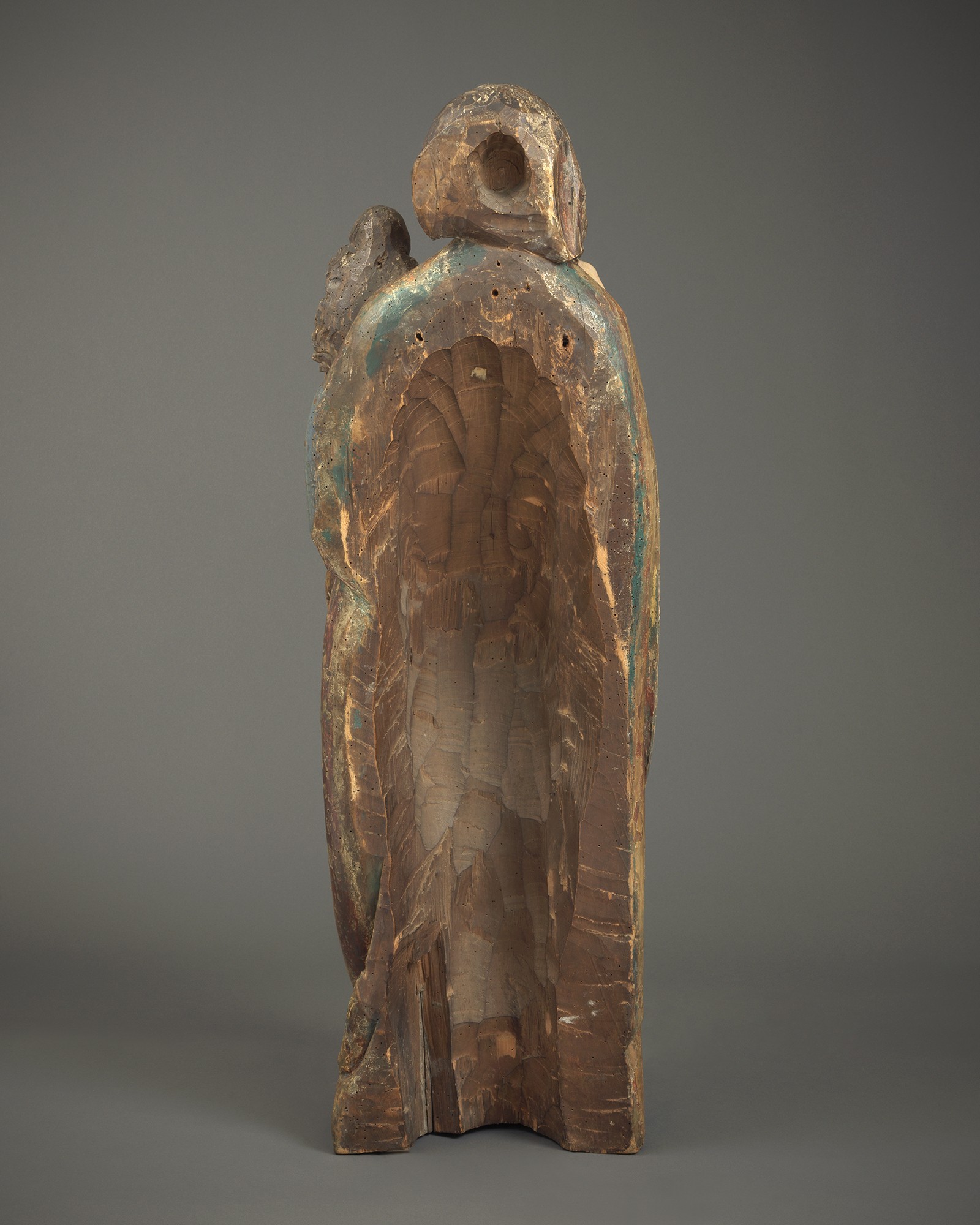


From a cloister in Schwyz, Switzerland, probably the Einsiedeln Kloster or Frauenkloster St. Peter am Bach
Josef Kastner, the Elder (1810-1872) Collection, Vienna
His sale, Dorotheum, Vienna, 4-6 December 1911, lot 63
Private collection, Belgium
Museum Bergbau und Gotikmuseum, Leogang, 2017 – 2018 (on loan)
C. Lichte and H. Meurer (eds.), Die mittelalterlichen Skulpturen, Bd. 2. Stein und Holzskulpturen 1400-1530: Ulm und südliches Schwaben, exhibition catalogue (Landesmuseum Württemberg, Stuttgart, 2007), no. 79
D. Flühler-Kreis and P. Wyer, Die Holzskulpturen des Mittelalters: Katalog der Sammlung des Schweizerischen Landesmuseums Zürich (Schweizerisches Landesmuseum, Zürich, 2007), pp. 231-232
In this beautiful group the standing Saint Anne holds the Christ Child in her right hand, the toes of his right feet held between her third and fourth fingers, a small open fruit in the palm of his left hand symbolising the Passion. Her daughter, the Blessed Virgin, balanced in her left hand, reads the open gospels. Both daughter and mother are enchanting, the Virgin with a delicate face, rose cheeks and long thick curls of blonde hair cascading down her shoulders and the length of her back, Saint Anne with a refined elegant poise, her full veil covering her forehead and framing her older but dignified features. The Virgin’s eyes fixed on the word of God, her mother looks directly at the viewer, the scene calm and serene.
With its sweet faces and elaborate creased drapery, the present object can be connected to the sculpture produced in the workshops of Ulm and recalls the work particularly of Niklaus Weckmann (see, for example, a version of the same subject from his workshop in the Landesmuseum Württemberg, Stuttgart (see Lichte, op. cit.). The separate hollowing of the back of Anne's head, as seen in our example, is characteristic of sculpture within Weckmann's circle active in Ulm during the first decades of the 16th centuy. There are also parallels between our group and sculptures produced in Lucerne, one illustration being the Anna Selbdritt now in the Landesmuseum, Zurich, the facial features of that Saint Anne and the figures of the Virgin and Christ Child mirrored to such an extent that an origin from the same workshop is plausble (Inv. no. LM 3405.59) (see Flühler-Kreis and Wyer, op. cit.). A Swiss pedigree would also fit with our sculpture having been in a cloister in the canton of Schwyz, most probably the Einsiedeln Abbey, prior to its inclusion in the collection of the Austrian painter, Josef Kastner, the Elder (1810-1872). The group may have been carved either in Ulm or in a Swabian-influenced workshop in Lucerne. A label is fixed to the underside inscribed: ‘13’.
Saint Anne is not a biblical figure. She appears first in a second century apocryphal infancy gospel as part of the story of the Saviour’s birth and maternal ancestry. Over the centuries her story circulated throughout eastern and western Christendom but it was not until the late Middle Ages that the cult of Saint Anne became firmly established. Especially popular in German speaking regions from the 14th century, the veneration of Saint Anne as chaste wife, mother and grandmother reached its zenith between 1480 and 1520. She was seen as a figure of devotion among medieval Christians who found solace in her closeness to Jesus and Mary. The increase in her popularity followed extensive promotion of the saint's cult by Netherlandish and Rheinland German humanists and reforming clerics that began in the 1480s in the manifestation of the founding of confraternities dedicated to her and in the writing of lives and other texts. These texts, republished elsewhere in Germany, were of crucial importance in heightening Saint Anne’s popularity for they attributed to her a power unprecedented in saints’ lives – the power to assist in the achievement of salvation. Artists sought to emphasise this power derived from her physical connection to the Redeemer and his mother. The power ascribed to Saint Anne had special appeal for German Christians who, in the 15th century, were showing a heightened concern over individual salvation. The attempt to encourage membership in Saint Anne confraternities was part of a larger clerical program to control and shape lay piety in the late medieval North, in part in response to anxieties over lay, especially lay women's, religious activities, and in part in response to financial pressures.
In the most widely reproduced troupe, known as Anna Selbdritt ('Anne herself the third'), Saint Anne symbolises family life. She is believed to have married three times, having one daughter with each husband. In our beautifully balanced and well preserved example, both she and the Virgin are cloaked in voluminous robes with exquisitely carved deep folds and extensive remains of the original polychrome and gilding. As is typical, Saint Anne wears the veil of a widow. With the hint of a half-smile, her face is warm and inviting, her gaze tranquil and reassuring. In comparison to other fine representations where the two women are seated (see, for example, Related Works below), this charming version with the standing Anne holding the infant Jesus and his mother was an equally popular composition. Our image of three generations of the Holy Family shows an intimacy and tenderness which is often apparent in this type of iconography.
SOLD: Speed Museum, Louisville, Kentucky, United States